| Botanical Name |
|
| Family |
Fabaceae - The legume and pod-bearing family. (Pea & Bean Family) |
| Pronunciation |
er-ith-RY-nuh hew-mee-AH-nah |
| Common Name(s) |
|
| Plant Group |
- Shrub A woody plant of relatively low height, having several stems arising from the base and lacking a single trunk; a bush.
|
| Plant Size |
- Medium
| Tree | 10m to 16m |
| Shrub | 1m to 2m |
| Perennial/ground cover | 40cm to 60cm |
| Bulb | 40cm to 60cm |
| Succulent | 40cm to 60cm |
|
| Position |
- Sun The area is in full sun for all or most of the day, all year round.
|
| General Information |
- Attractive fruits, berries or seeds Brightly coloured fruits or berries increase and extend the visual impact of the plant and are especially attractive to birds and other small wildlife.
- Deciduous Plants which completely lose their foliage for part of the year.
- Drought Tolerance: High The plant is well adapted to arid conditions; it can survive long periods of drought and high temperatures without extra water.
- Frost: Hardy The plant can withstand freezing temperatures or frost without artificial protection.
- Thorns / Spines / Prickles Thorn: A hard, woody, pointed branchlet.
Spine: A modified leaf forming a hard, sharp-pointed outgrowth.
Prickle: A small, sharp-pointed outgrowth growing from the bark of the plant.
- Water Wise Plant species originating from low rainfall regions that require less water to survive and thrive than other plant species.
|
| Specific Information |
Erythrina humeana is a deciduous shrub or occasionally a small tree, often multi-stemmed, which produces scarlet flowers on black flower stalks that reach out above the foliage. This tree was surely developed with high density housing in mind. Its nectar rich flowers attract a wide variety of birds and is especially appreciated by sun birds. It is easy to grow and can be used in small gardens or large containers. The swollen rootstock can be displayed if the plant is grown as a bonsai.
|
| Ad Break |
|
| Flowers |
| Description |
Pea-flowers in spiked heads on attractive long black stems held above the foliage
|
| Season |
- Summer Plants will seldom bloom for the entire season as given in the list, but should flower during a period within these parameters.
|
| Colour |
|
| Growth Rate |
- Moderate to Fast Specifying growth rate can be very misleading as there is considerable variation of growth rate depending on type and species of plant, available water, supplementary feeding, mulching and general care, as well as the plants suitability and adaptability to the garden environment.
|
| Plant Uses |
- Accent or Focal Point A plant used to attract the attention because of its colour or form.
- Attracts bees, butterflies or other insects This plant attracts insects which can be food for birds or other creatures in your garden.
- Attracts Birds This plant will attract birds.
- Container Trees, shrubs and ornamental species that can adapt to growing in a restricted environment.
- Filler Either a fast growing tree or shrub used temporarily to fill in an area while the permanent plants grow to a desired size, or a plant used to fill gaps in borders or beds.
- Provides light / dappled shade A tree with an open to sparse canopy, through which varying degrees of sunlight can penetrate.
- Rock Garden An area constructed of larger rocks, arranged naturally, to emphasise the use of stones as a main element. Generally plants used do not need a lot of care.
- Suitable for bonsai A shrub or tree that lends itself to being dwarfed.
- Suitable for coastal gardens Plants adapted to dry, sandy soil, forceful wind, limited rainfall and intense sunlight.
- Suitable for seaside gardens Plants that will survive the hostile environment of harsh salty winds, dry sandy soil, irregular rainfall and heat found in seaside gardens.
- Suitable for smaller gardens Such plants do not have invasive root systems, remain small or controllable and can often be grown in containers.
- Wild Garden An indigenous garden planted for the benefit of wildlife and birds. Provides food, water, a variety of mini-biomes and no poisonous chemicals are used.
|
| Distribution and Habitat |
along the coast from the Eastern Cape, through KwaZulu-Natal to Mpumalanga and Limpopo, and in a narrow strip up the coast of Mozambique, in dry scrub, open wooded grassland and bushveld, on rocky outcrops, mountain sloped and coastal dunes
|
| Planting Suggestions |
Plant in a well-prepared hole or container with good garden soil mixed with compost, a little bone-meal and fertilizer of your choice. With its small dimensions the dwarf coral tree is ideally suited to housing complexes where garden space is limited.
While this plant is incredibly attractive when in bloom, I have noted the foliage is often infested with whitefly and on occasion a sooty mould, which gives the foliage a blackish grey appearance. It needs to be carefully watched so that infestations can be timeously averted.
|
| Medicinal Uses |
An extract of the root is used externally as a poultice for sprains and is taken internally for treating tuberculosis, bronchitis and other chest complaints. The bark is burnt and the ash is applied to the umbilical cord of new born babies.
|
| Ad Break |
|


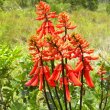
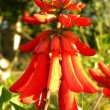
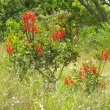
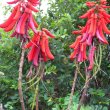
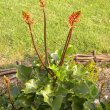

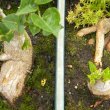


Comments
Erythrina humeana
What is best to used against whitefly and the sooty mould on the leaves?
Whitefly on erythrina humeana
I had one planted down the side of the house where the plant received sun between 10am an 14pm in summer. It was also quite humid in that location.
I had a severe psyllid infestation on the plant.
I read up and found out the Psyllid endemic to SA does not like hot dry conditions.
I moved the plant to a position where it received full sun all day, wind is also good, and the psyllid infestation went away. Now and then the odd leaf gets infected but I pull it off.
This should work for sooty mold and whitefly as well.
Thanks Ian
Discuss this plant
Share knowledge, ask a question or give an experience.